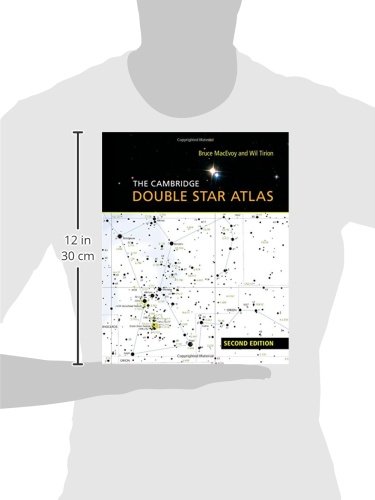



Full description not available
B**1
My new atlas of choice.
I'd been using the Pocket Sky Atlas for about 20 years, and had no complaints. But recently I began observing Double Stars, I ran across this atlas and figured it would be a worthy addition, since it not only labels the double stars on the charts, but also has extensive information for most of them in the appendix.The more I used this atlas, the more I liked it. Slightly larger in both charts and font size labels, it works better for my 61-yr-old eyes. Since I'm a urban-based observer, this atlas more than covers any object I might want to observe, not only double stars but numerous nebulae, clusters, and galaxies down to a certain magnitude. More than I'll ever be able to see under the city skies where I observe from, so I'll never need anything else.Easy to use, charts are laid out logically with just the right amount of overlap, and tons of information right there at your fingertips. What's not to like?
D**H
Excellent!
The traditional book of Star Charts seems to be getting harder and harder to find! Guess all the "Kids" (or the under 30 crowd!) are fully dependent on electronics or Computers 🖥 to find anything in the sky!I bought multiple examples of both editions of "Sky Atlas 2000" just to be sure I ALWAYS have a copy on hand.They seem to have gone "Out of Print"! WHY? I don't know. If you've driven way out in the boonies just to enjoy a "Dark Sky" observing site, electricity will be at a premium. What ever "juice" your RV, Motorhome or Trailer can supply will be IT! So, you better have some sort of planesphere or print ATLAS on hand, OR your trip could be a total bust!
B**Y
A great help for my binoculars and telescope.
I've learned alot using the Cambridge Double Star Atlas. I use it with both my binoculars and telescope. Great Addition to my library.
V**.
Unbeatable!
Cambridge Binary Star Atlas. If you want large, constellation-scale, full-page color star maps showing all significant celestial objects, look no further! You can't find a better book. Recommend the spiral version - easier to work with. The companion Cambridge Single-Star Atlas is almost as good - the maps are also large but mostly half-page. As you would expect, there is a fair amount of map coverage overlap between the two books; but this is unavoidable. No star duplications, of course.Thanks to seller - book arrived fast, on time, in perfect condition. abh
D**Y
Very useful for DS work
Very useful for DS observation.DSs are numbered, and table at back gives components, magnitudes, separation, position angle, and other very useful data.
C**G
Truth in Labelling
It nice to have a star atlas that shows labeling for all classes of celestial objects. Double and multiple stars get equal labeling privileges along with deep-sky objects of all kinds and variable stars.
A**R
Great for doubles and Messier objects
This is my go-to star atlas these days. In addition to double stars (multiple/binary systems) it also has the Messier objects, in a scale I find very useful. With the detail provided, I can usually start with the atlas and binoculars and find enough stars to create a path to my target object. It also has a nice tutorial at the beginning on about double stars, including info about how to observe them. The only annoyance, which keeps it from getting 5 stars, and it might not bother anyone else, is the charts don't distinguish between the doubles that are in the target list and those that aren't. As other reviews have noted, the target list (the index of double stars that contains all their data like magnitude, separation, and position angle) only includes stars that are considered today to be true multiple star systems. "Visual" line-of-sight doubles are not included in the target list. Which is ok, except these "legacy" doubles are included on the charts. This creates a little confusion and frustration, when I try to look up a star shown on the chart and it's not on the list. I think it would be better to either just not indicate the "legacy" doubles on the chart at all, or else include their data,or else maybe find a way to distinguish the "legacy " doubles from the true doubles on the chart itself.But once you know about this, just enjoy the beauty and utility of the atlas. It holds up well to dew and is easy to navigate and use at the telescope. The page numbers are large and easy to find, as are the chart index pages. The Target list has all the data you could want about the star systems, with brief notes about the more interesting ones. I recommend it for sure if you like double stars, and even if you don't, it's still a good star atlas for Messiers. I used it to complete my Astronomical League Double Star program, and it's almost gotten me through the Messier program as well.
C**N
very useful in the field
I am an amateur astronomer who enjoys observing double stars. I always take the double star atlas with me to my observing site.
Trustpilot
1 week ago
4 days ago